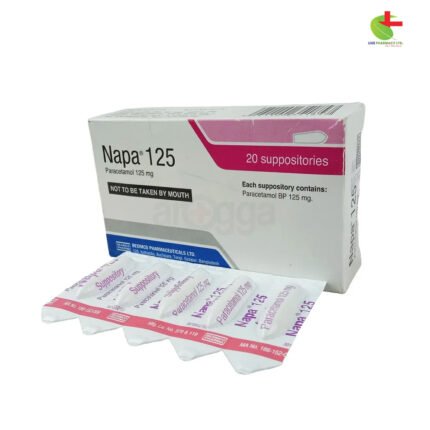Napa 250 Suppository
5.00৳ Pcs
- Napa is an analgesic and antipyretic used to relieve pain and fever.
- Effective for headaches, toothaches, joint stiffness, and discomfort from colds and flu.
- Suitable for both adults and children, offering safe and quick relief.
- Well-tolerated formula, minimizing side effects associated with aspirin.
- Consult a healthcare provider for appropriate dosing.
 Brand
Brand
|
Beximco Pharmaceuticals Ltd |
|---|---|
 Generics
Generics
|
Paracetamol |
 Type
Type
|
Suppository |
Indications
Napa is effective in treating a variety of conditions, including fever, common cold, influenza, headaches, toothaches, earaches, body aches, myalgia, neuralgia, dysmenorrhea, sprains, colic pain, back pain, postoperative and postpartum pain, inflammatory pain, and pain following vaccinations in children. It is also suitable for alleviating pain and stiffness associated with rheumatism and osteoarthritis.
Pharmacology
Paracetamol, the active ingredient in Napa, is renowned for its analgesic and antipyretic properties, with minimal anti-inflammatory effects. It primarily works in the central nervous system (CNS) by raising the pain threshold through the inhibition of cyclooxygenase enzymes (COX-1, COX-2, and COX-3), which are essential for prostaglandin synthesis. As a derivative of para-aminophenol, paracetamol is one of the safest and fastest-acting analgesics, well-tolerated and free from the side effects commonly associated with aspirin.
Dosage & Administration
- Tablet:
- Adults: 1-2 tablets every 4 to 6 hours, not exceeding 4 grams (8 tablets) daily.
- Children (6-12 years): ½ to 1 tablet 3 to 4 times daily; do not exceed 2.6 grams per day for long-term treatment.
- Extended Release Tablet:
- Adults & Children over 12 years: Two tablets every 6 to 8 hours (maximum of 6 tablets in 24 hours). Do not crush the tablets.
- Syrup/Suspension:
- Children under 3 months: 10 mg/kg body weight (reduce to 5 mg/kg if jaundiced) 3 to 4 times daily.
- 3 months to 1 year: ½ to 1 teaspoonful 3 to 4 times daily.
- 1-5 years: 1-2 teaspoonfuls 3 to 4 times daily.
- 6-12 years: 2-4 teaspoonfuls 3 to 4 times daily.
- Adults: 4-8 teaspoonfuls 3 to 4 times daily.
- Suppository:
- Children (3-12 months): 60-120 mg, 4 times daily.
- Children (1-5 years): 125-250 mg, 4 times daily.
- Children (6-12 years): 250-500 mg, 4 times daily.
- Adults & children over 12 years: 0.5-1 gm, 4 times daily.
- Paediatric Drop:
- Children up to 3 months: 0.5 ml (40 mg).
- 4 to 11 months: 1.0 ml (80 mg).
- 1 to 2 years: 1.5 ml (120 mg). Do not exceed 5 doses daily for a maximum of 5 days.
Paracetamol with Actizorb technology dissolves up to five times faster than standard tablets, making it a rapid and safe analgesic option.
Interaction
Concurrent use with barbiturates, tricyclic antidepressants, and alcohol may impair the metabolism of Napa, while alcohol can heighten the risk of hepatotoxicity. Chronic use of anticonvulsants or oral contraceptives may also alter therapeutic levels of Napa.
Contraindications
Napa is contraindicated in individuals with a known hypersensitivity to paracetamol.
Side Effects
Side effects are generally mild, including diarrhea, indigestion, and occasional rashes. Rarely, serious haematological reactions like thrombocytopenia and agranulocytosis may occur.
Pregnancy & Lactation
Studies indicate that paracetamol, when used at recommended doses during pregnancy, shows no harmful effects. It is excreted in breast milk in minimal amounts, and breastfeeding is generally considered safe while taking Napa.
Precautions & Warnings
Caution is advised when administering Napa to individuals with severe renal or hepatic impairment, as the risk of overdose is heightened in patients with liver disease. Patients should avoid taking other products containing Napa simultaneously.
Overdose Effects
Liver damage is a concern with doses exceeding 10 grams in adults. Symptoms of overdose may include pallor, nausea, vomiting, and abdominal pain within the first 24 hours. Immediate medical attention is critical. Activated charcoal may be administered if the overdose occurred within an hour. N-acetylcysteine may be used as an antidote, particularly effective if given within 8 hours post-ingestion.
Therapeutic Class
Non-opioid analgesics
Storage Conditions
Store in a dry place, away from light and heat. Keep out of reach of children.













Reviews
There are no reviews yet.